India, the land of spices, of spiritual influence on food and it’s people and one of the oldest civilizations in the world is where we touch down for the next leg of our International Cooking Tour. Fragments of India’s history can be traced back as far as 700,000 years ago. India’s 26 states hold virtually every kind of landscape imaginable. To simplify a very long and complex history we will divide the country into 4 regions as we savor the food, cleanse our bodies and take time to reflect through the gratitude of food.
To the western mind, India is perceived as a largely vegetarian cuisine but this is not necessarily true. To a large extent, religious beliefs, as compared to personal preference, dictate what a person eats. For example Islam forbids it’s followers to eat Pork, while many Hindus do not eat Beef. Followers of the Jain faith are strict vegetarians. As we divide India into four culinary regions, each region will have several states in it and each state will have its own unique food.
Mongolians brought their hotpot style of cooking, Persians, who established the Mughal Rule in India in the early 16th century, introduced elegant dining and rich foods with dried fruit and nuts. Muslims from western Asia introduced leavened breads. The combination of these two cultures resulted in a magnificent cuisine called Mughlin Cuisine. The lamb Kebabs were laced with spices, the rice pilaf of India was turned into Biryanis (layered rice, meat/vegetable, spice and yogurt recipes). Royal Chefs created cylindrical clay ovens known as Tandoors and Indian Rotis and leavened breads were turned into Tandoori Naans. The Chinese introduced stir-fries and added sweet tastes to food. The Portuguese brought tomatoes, chile and potatoes to India. Together they influenced each others foods.
North India, which is the largest region, has extreme climates where the summers are hot and the winters are cold. The food traces it’s history from Persian ancestors who started filtering into the country in the 11th century A.D. A typical meal would consist of Pilafs, thick creamy Dals, vegetables seasoned with yogurt and unleavened flat bread. Tandoori styles of cooking originated in the North and the art of slow cooking where food is placed in a clay pot and dough is used to create a tight seal and prevent steam from escaping so the food is slowly cooked in it’s own juices and steam.
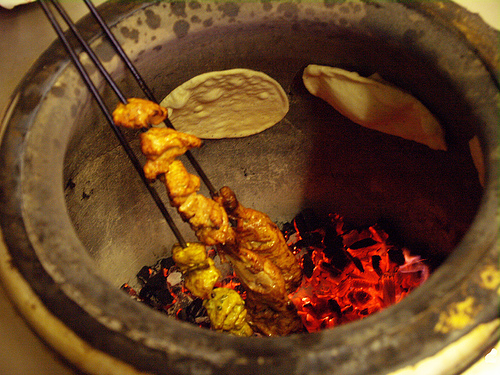
A tandoor oven is normally used to cook naan bread, meats and kebabs (meat or paneer). The bread is stuck to the sides, the kebabs stand vertically and whole chickens rest on a grid over the fire.
West India is considered the gateway to the western countries. The capitol of Maharastra, once called Bombay, now called Mumbai but maybe better known by it’s nickname “Bollywood” because it resembles our American film capitol, Hollywood is the main historical center of West India. Rice is the main food grain and peanut oil is the main cooking medium. Vegetables are steamed and lightly seasoned and there is very little deep frying and roasting used.
Foods in some areas were influenced by the Portuguese and they make a local favorite called Vidaloo, fiery hot and known as the “King of Curries”. Other areas were influenced by the Chinese and differ from most all Indian food in that sweets are served with the main meal. There are two different traditions in cuisine influenced by religion. The Hindus like lamb and chicken while the Christians prefer pork. They reach a harmony in their preferences when it comes to fish and seafood.
East India is the least explored region of India. Fish and rice are very important part of the diet because of the many rivers originating in the Himalayas. West Bengal is considered to be the cultural capitol of India and their fish curry is legendary all over India. Fish are also smoked, grilled, fried and made into patties. Mustard oil is used instead of ghee (Clarified butter).
South India has the fertile river valley of the Ganges River with a hot and humid climate but all of it’s states are coastal. The cuisine is rice based and has three basic categories: White Long Grain Rice is most commonly used, Short Grain Rice used to make sweet dishes and Round Grain rice used for worship representing Wealth, Health and Fertility. South Indian Dals and curries are soupier than north Indian Dals and curries. After all the spicy dishes, coconut water is drunk for its cooling effects.
One of the most well known Indian dishes has got to be Chicken Tikka Masala. There is still an ongoing battle about who is the creator of this dish and it rages on to this day. The Indians or the British? The base for the dish, it seems, pretty clearly dates back to the Mughal period of the 16th century. Tikka means “chunks” and there is a specific way of cutting the chicken into bite size pieces. These chunks of chicken are marinated in spices and yogurt and then baked in a tandoor oven. This style was supposedly invented by the first Mughal emperor, Babur, who was rumored to have been so afraid of choking on chicken bones he ordered his chefs to remove them. Now this is where the story of how Chicken Tikka Masala came to be in its current form and what is causing all of the hullabaloo.
British love to pour sauces and gravies on their foods. As the story goes, Ahmed Aslam Ali, owner and operator of the Shish Mahal Restaurant in Glasgow, claims to have invented the dish. In an interview he states, “We used to make chicken tikka and one day a customer said ‘I’d take some sauce with that, this is a bit dry’ so we cooked chicken tikka with the sauce which contains yogurt, cream and spices.” This story has become part of the tikka masala legend!
This is why we all love food so much. It really is the collaboration of many cultures putting their touches on food and each one elevating it to a new level. Today, there are more than 50 versions of this dish and the only common ingredient is, of course, chicken! When you taste this, you will understand why everyone is fighting to claim it as their own creation!
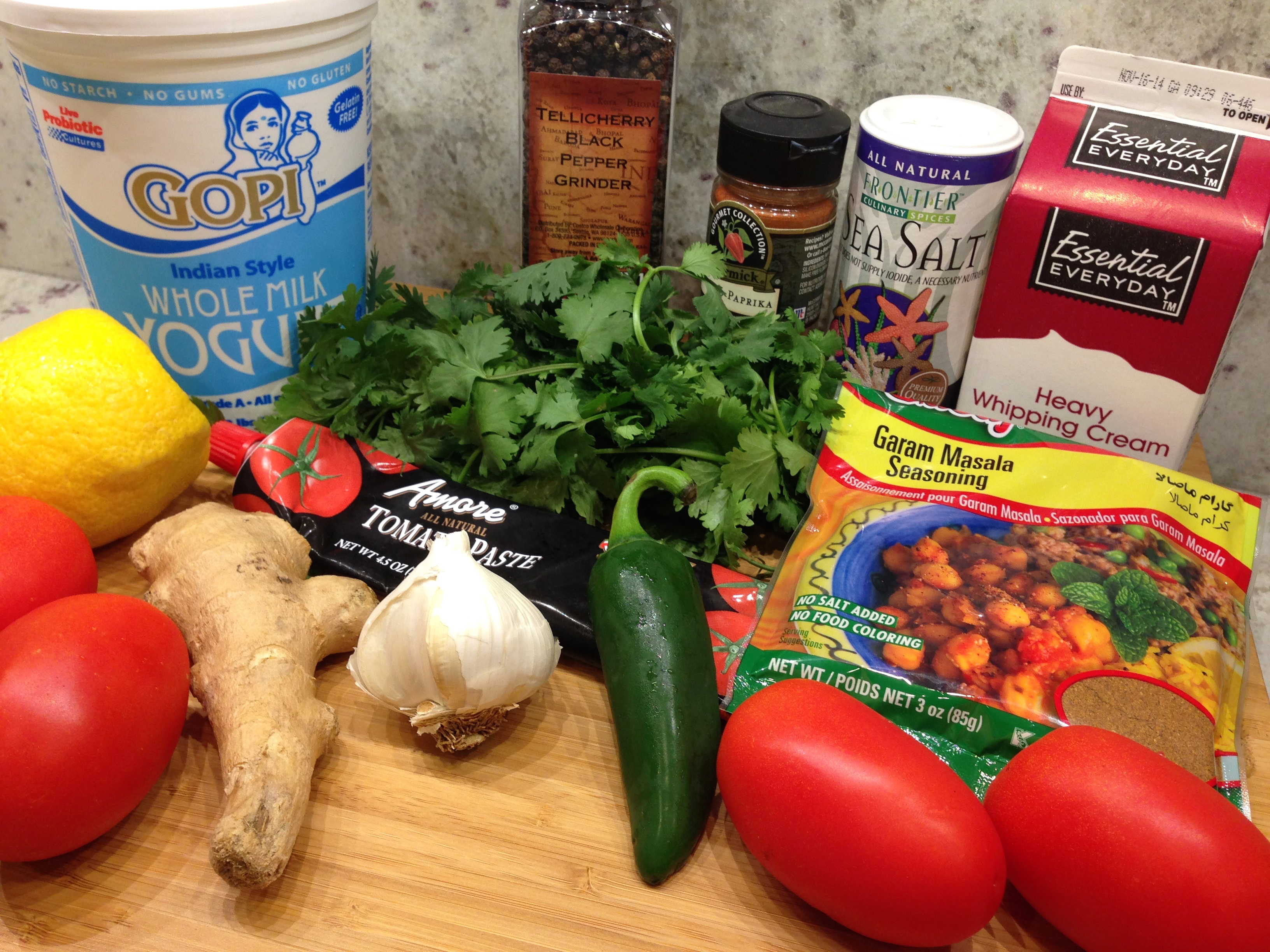
All the ingredients that give Tikka Masala it’s uniquely unmistakable flavor!
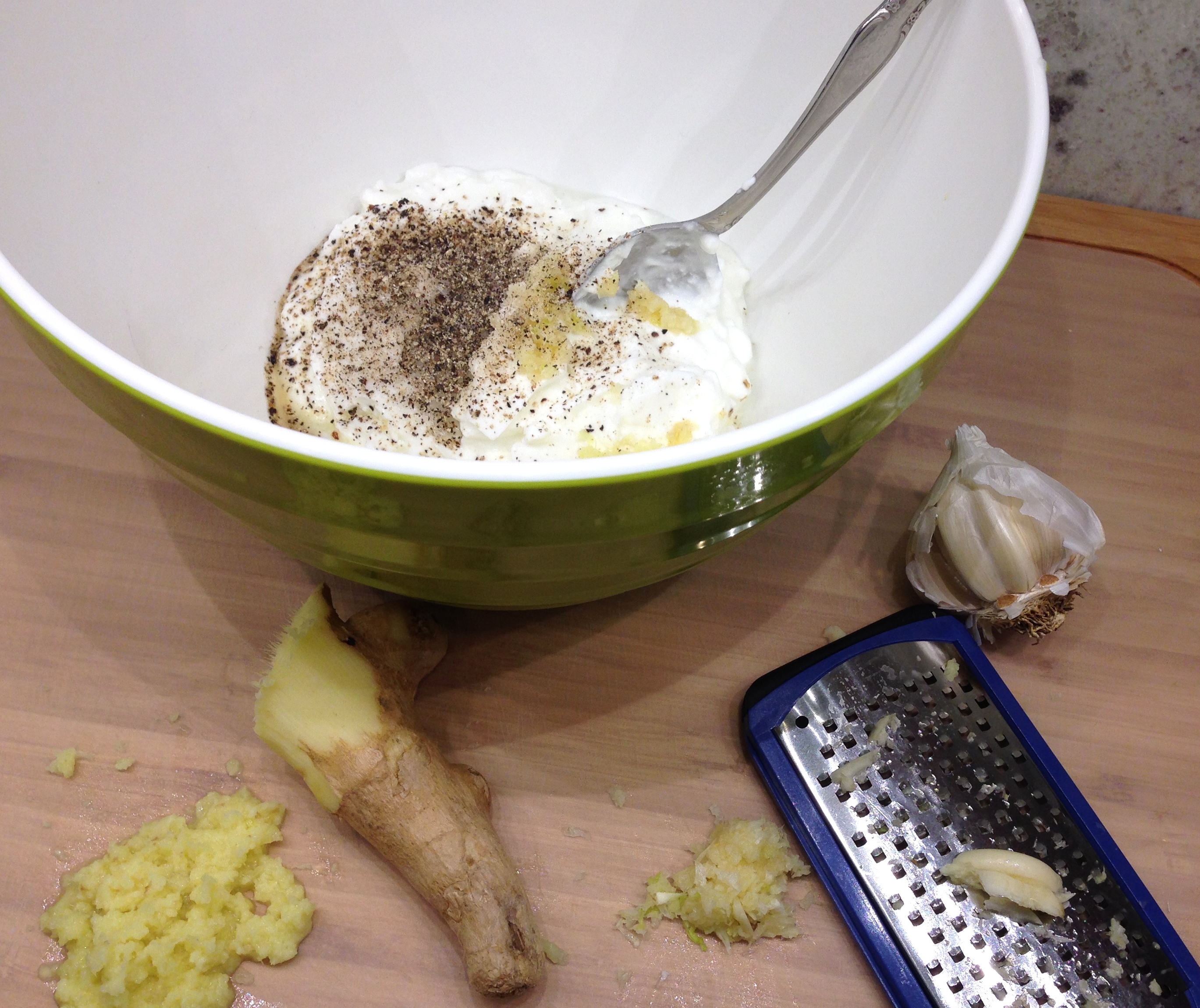
For the marinade, mix together the grated ginger and garlic, the yogurt, lemon and seasonings.
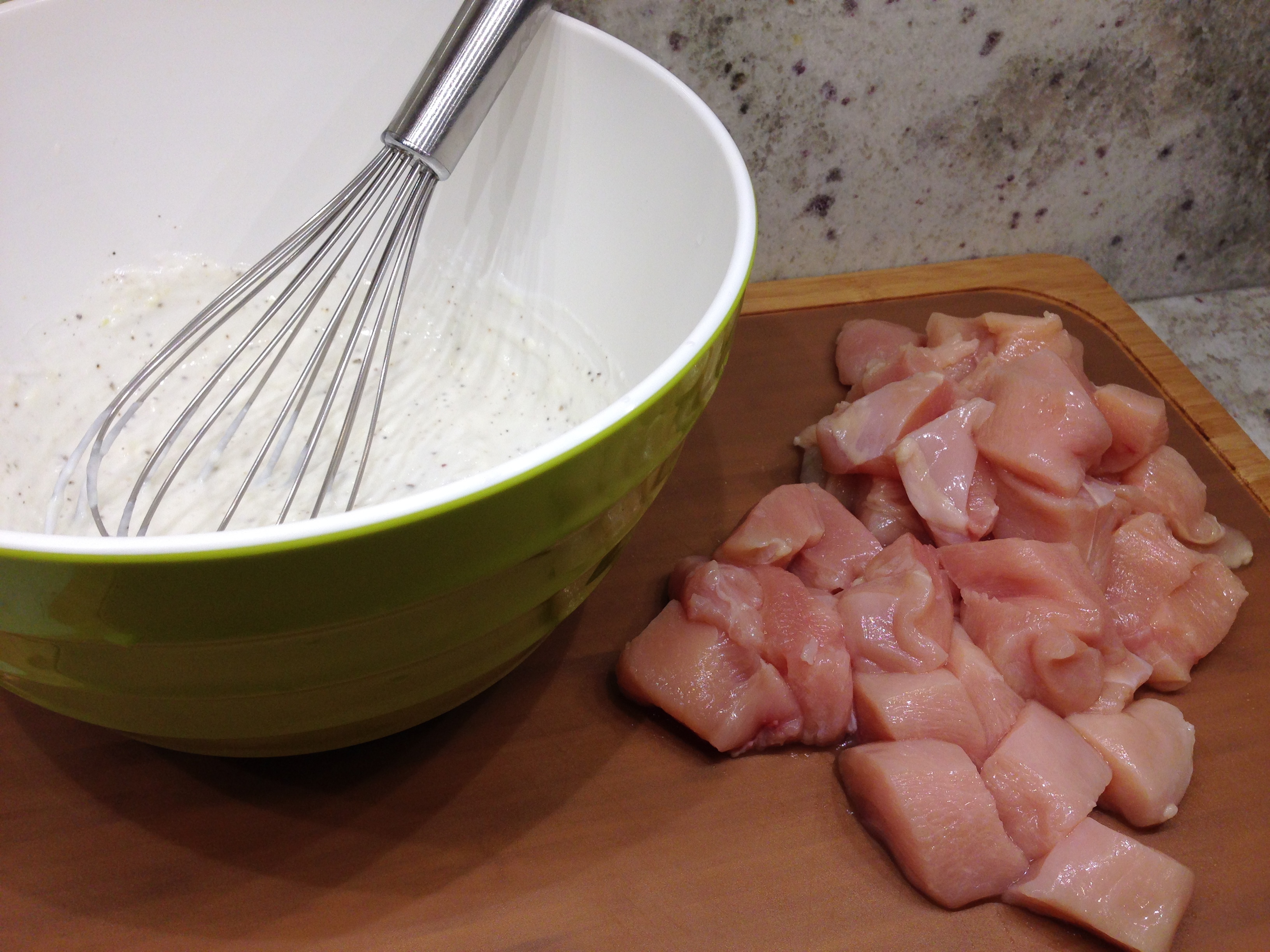
Cut the chicken into bite sized pieces and get them ready for their relaxing yogurt massage. The yogurt will break down the fibers in the chicken meat just like a good massage does for us. Happy, juicy chicken!
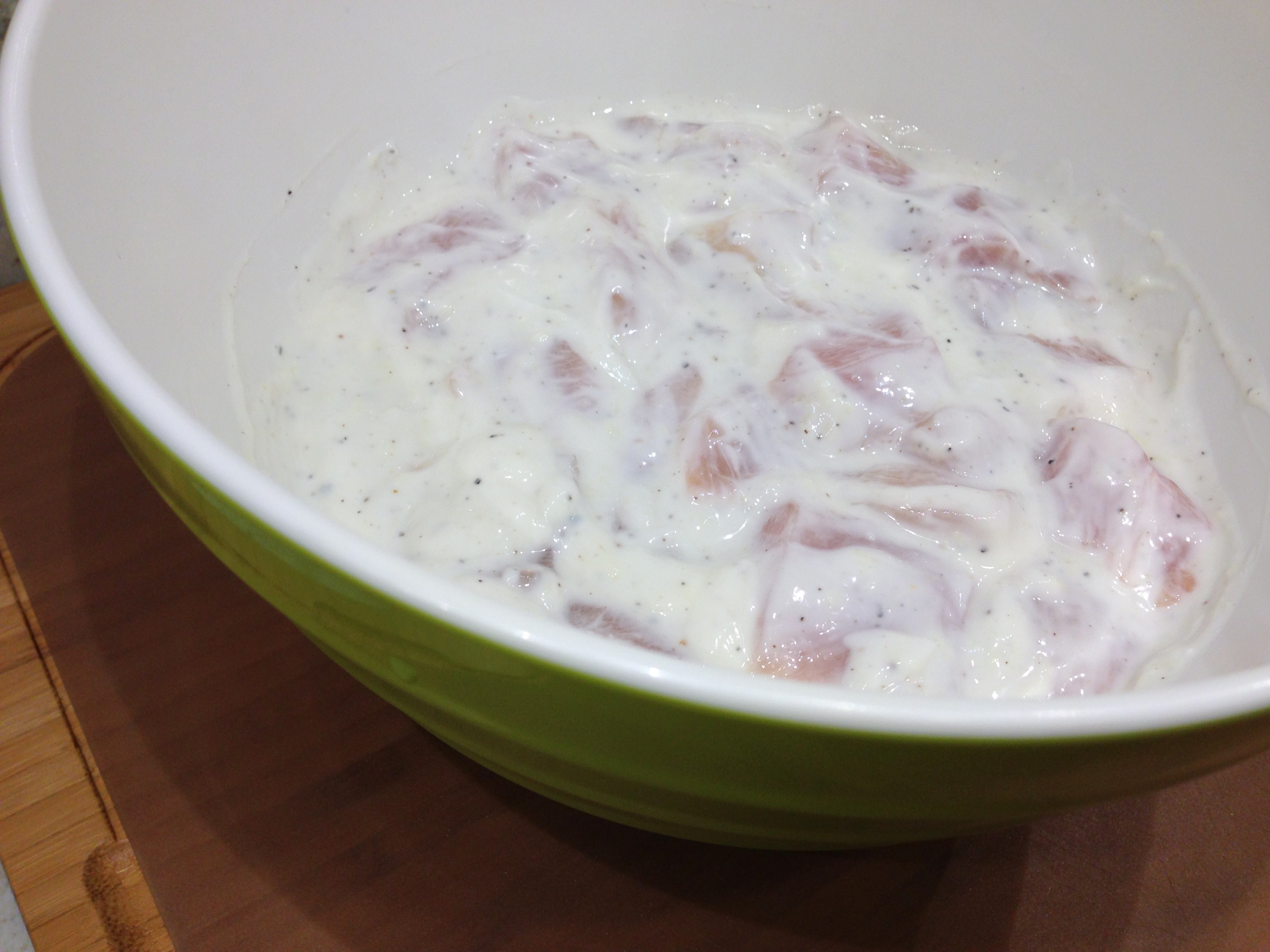
Add the chicken and toss to coat. Marinate at least 30 minutes, or in the refrigerator up to overnight. If you marinate overnight, don’t add the lemon and salt until right before cooking or it will make the chicken dry when you cook it.
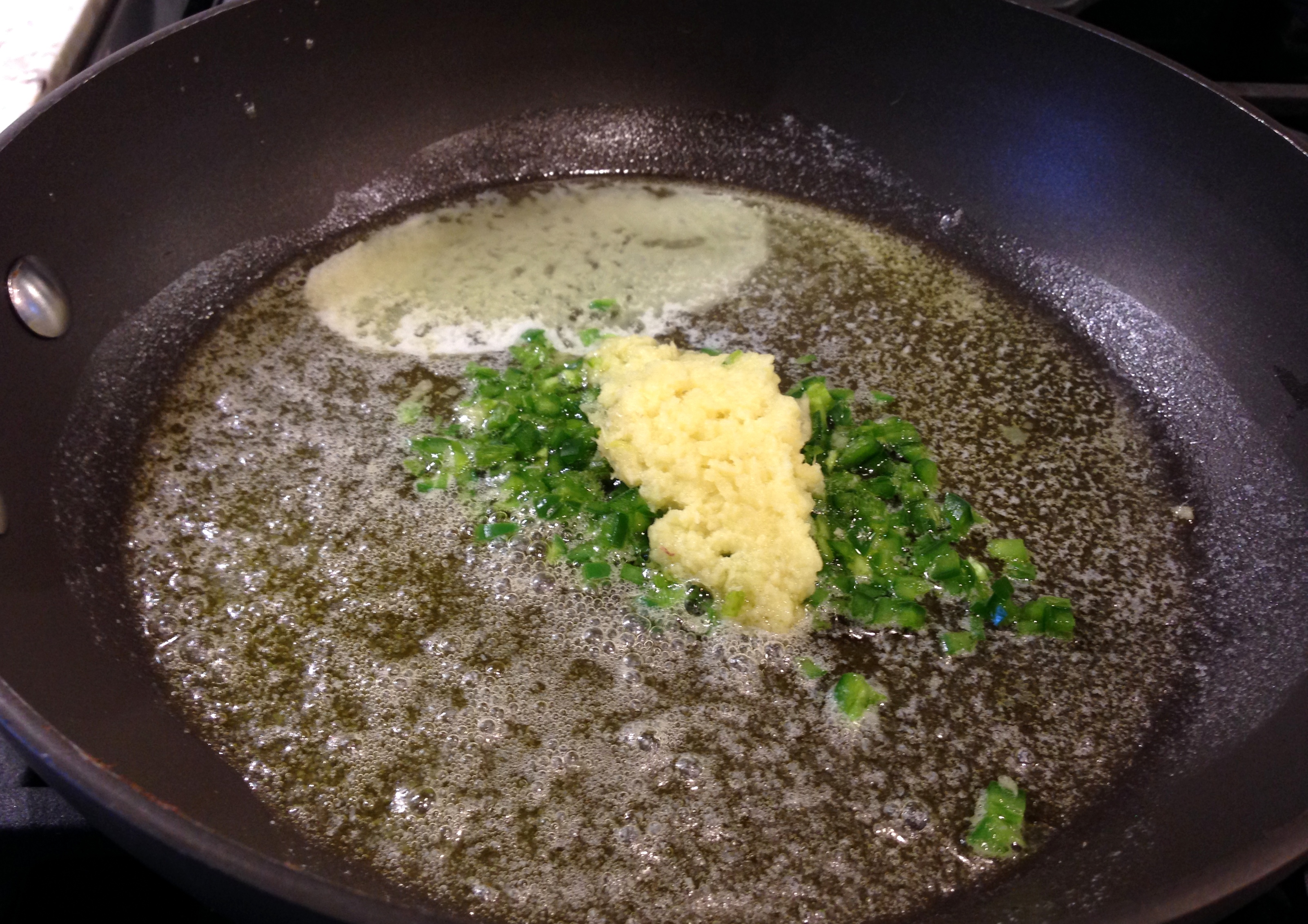
Now for the curry, place a large skillet over medium heat and add the olive oil and butter. When the butter has melted, add the ginger, garlic and serrano peppers. Saute until lightly browned around the edges.
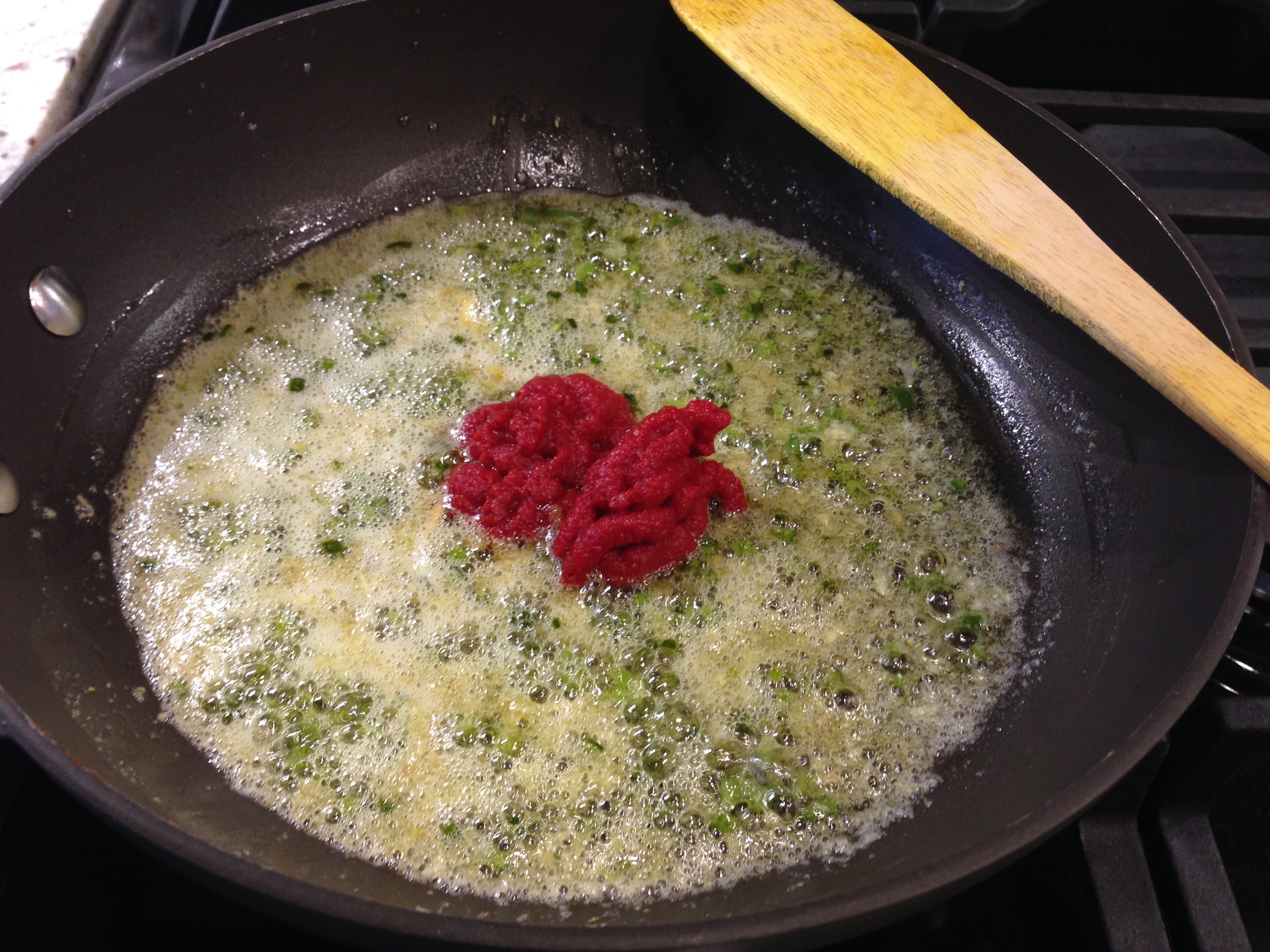
Add the tomato paste and cook until the tomato has darkened in color, about 3 minutes.
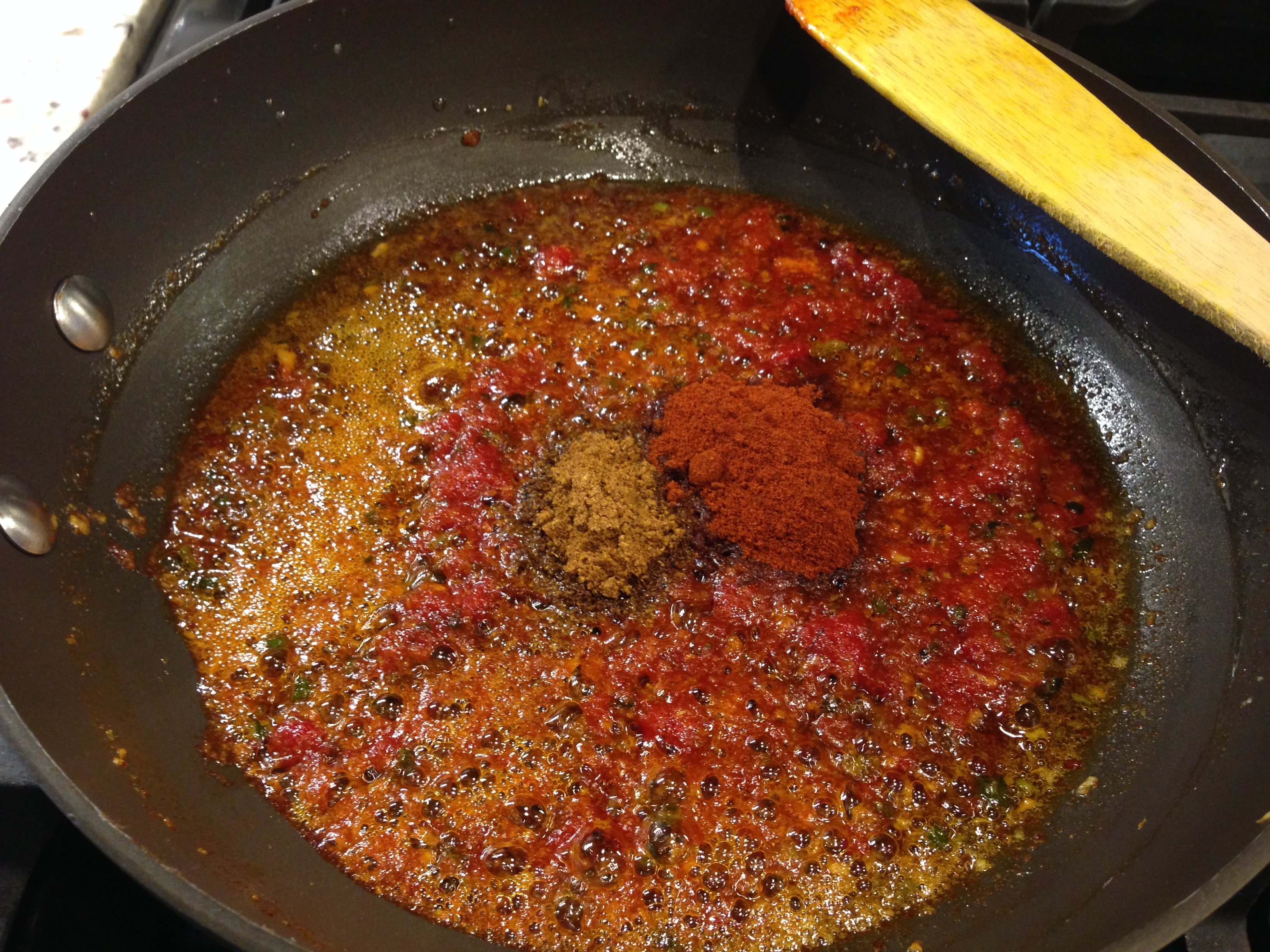
Add the garam masala and the paprika and saute for about 1 minute to bring out their flavors. Notice how the tomato sauce has gone from a bright red to a rich reddish brown. That’s flavor!
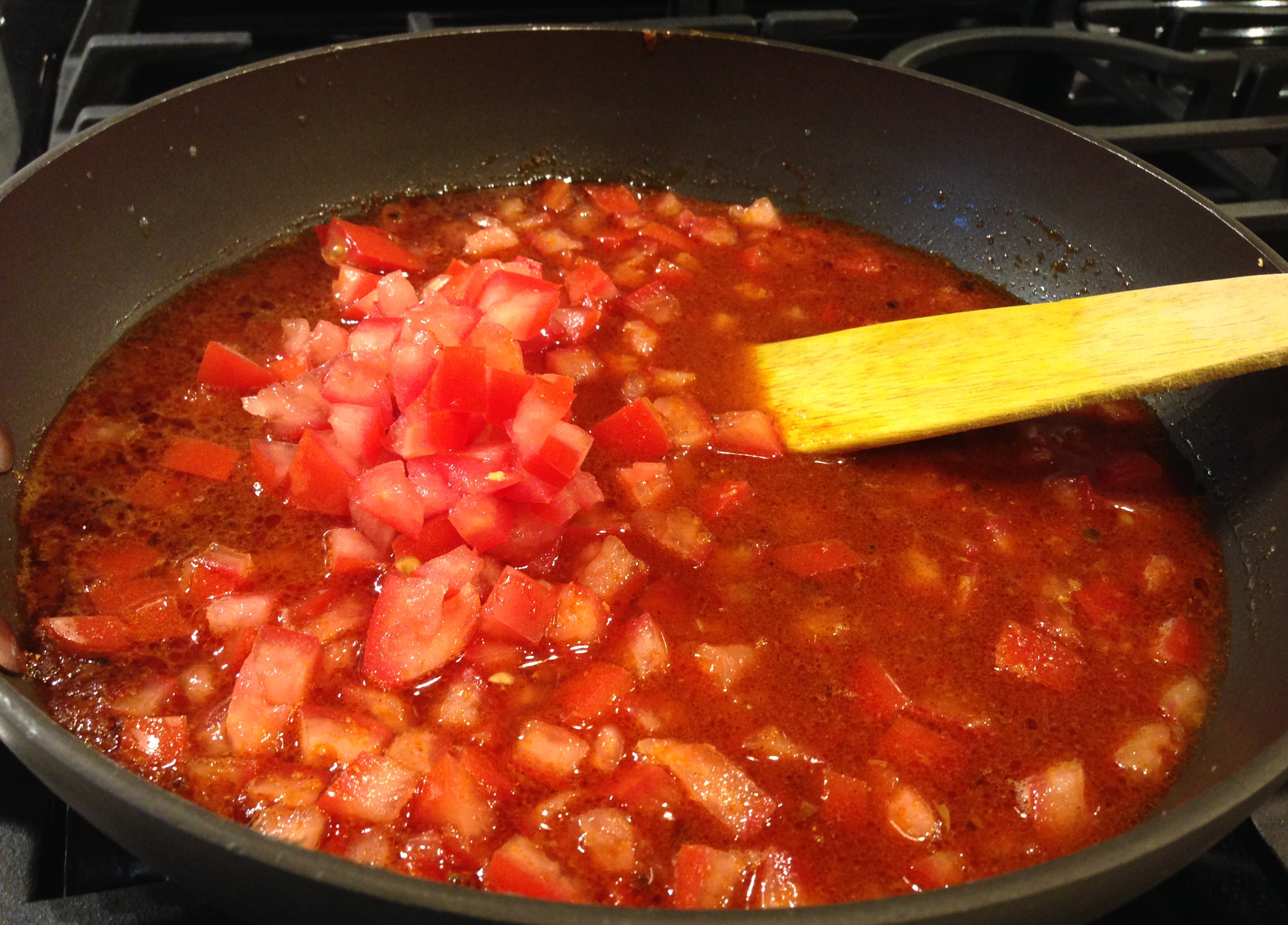
Add the tomatoes, salt, and 1 cup water, then bring to a boil.
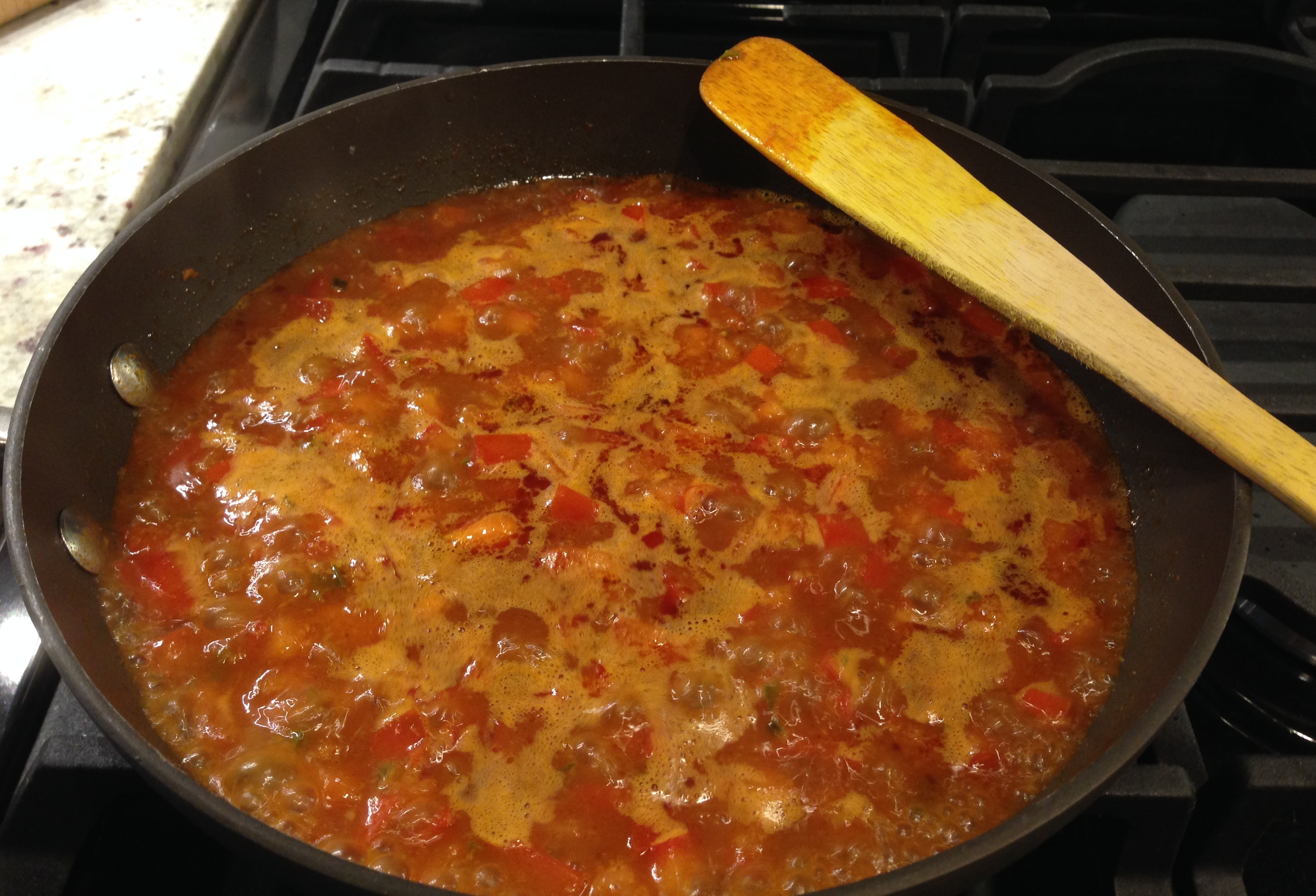
Turn down to a simmer and cook until thickened, about 20 minutes. It will reduce as the water evaporates and the sauce thickens. You may or may not need more water depending on how juicy the tomatoes are. You’re looking for a sauce not thicker or thinner than a pasta sauce.
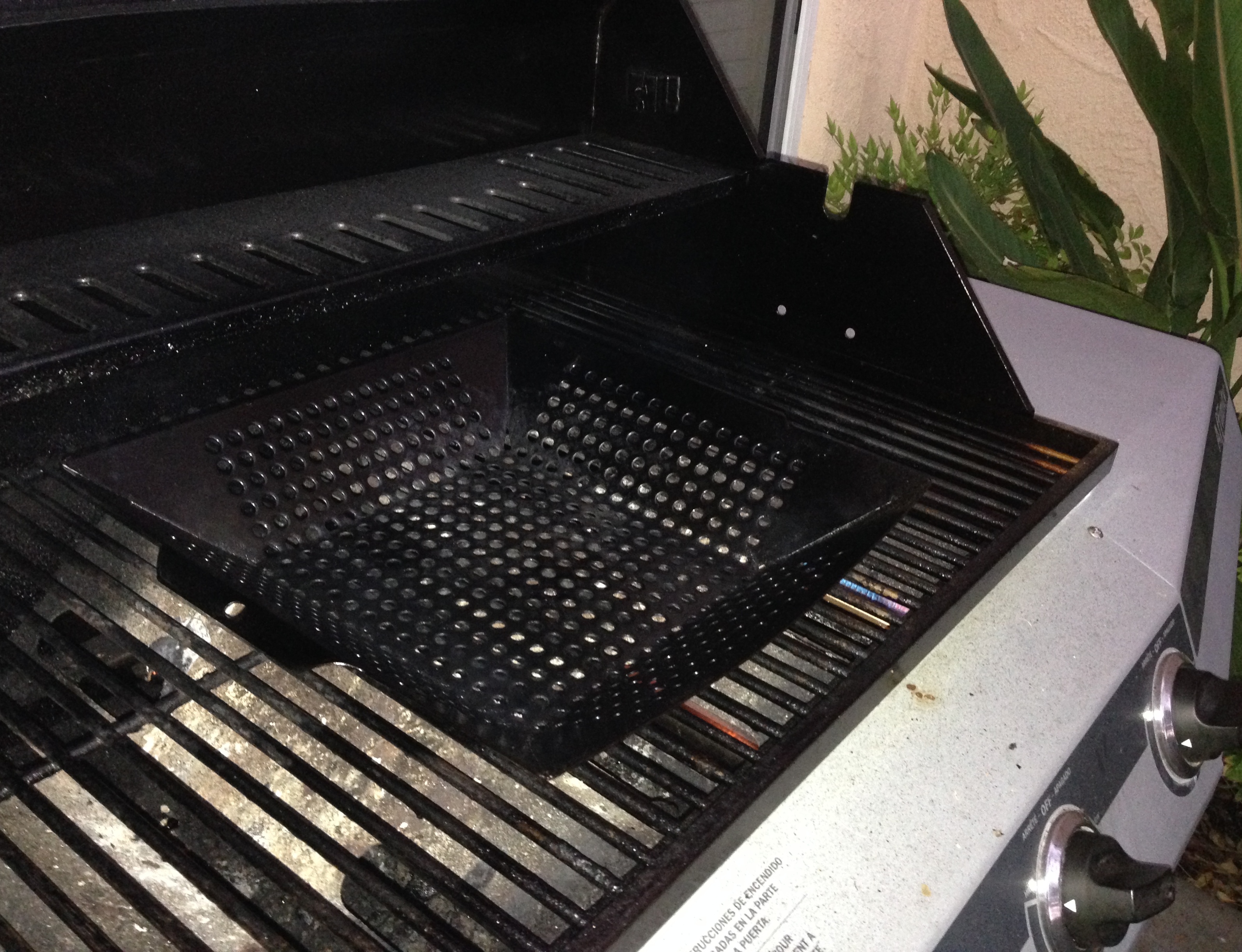
Fire up your grill. These grill pans are great for stir-frying vegetables marinated in Italian dressing too! If you’ve got smaller items that would slip through the grill, this is your answer to getting a great grilled flavor! When it is really hot, lightly brush the grill pan with oil and your ready to sear in the flavor!
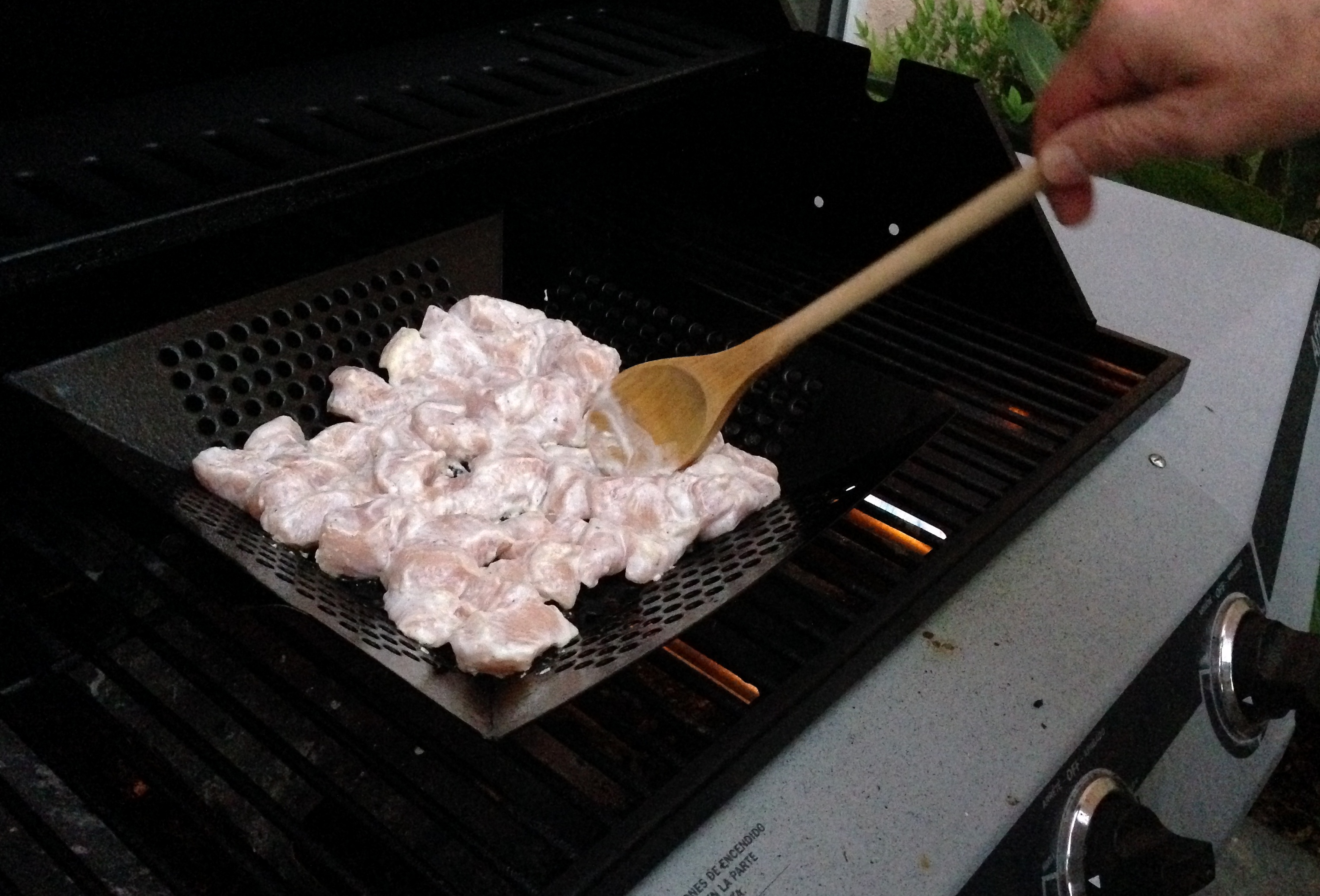
Place the chicken in the grill pan, shaking off some of the excess marinade. Cook until meat is very browned, about 2 minutes on each side. (Don’t worry that the chicken will still be a little uncooked, it finishes cooking in the sauce).
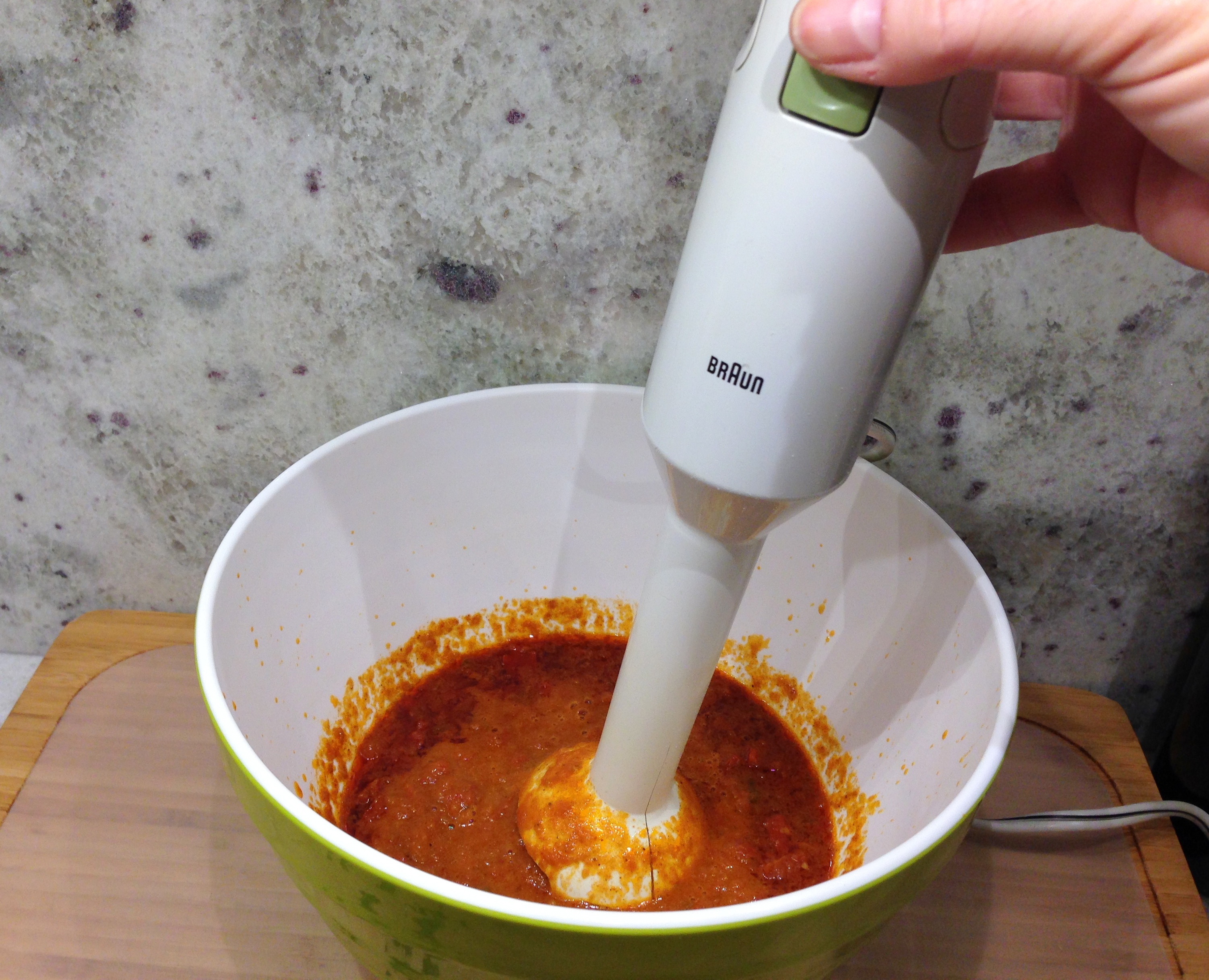
Pour the sauce into a blender or food processor, or a bowl and use an immersion blender; process until smooth.
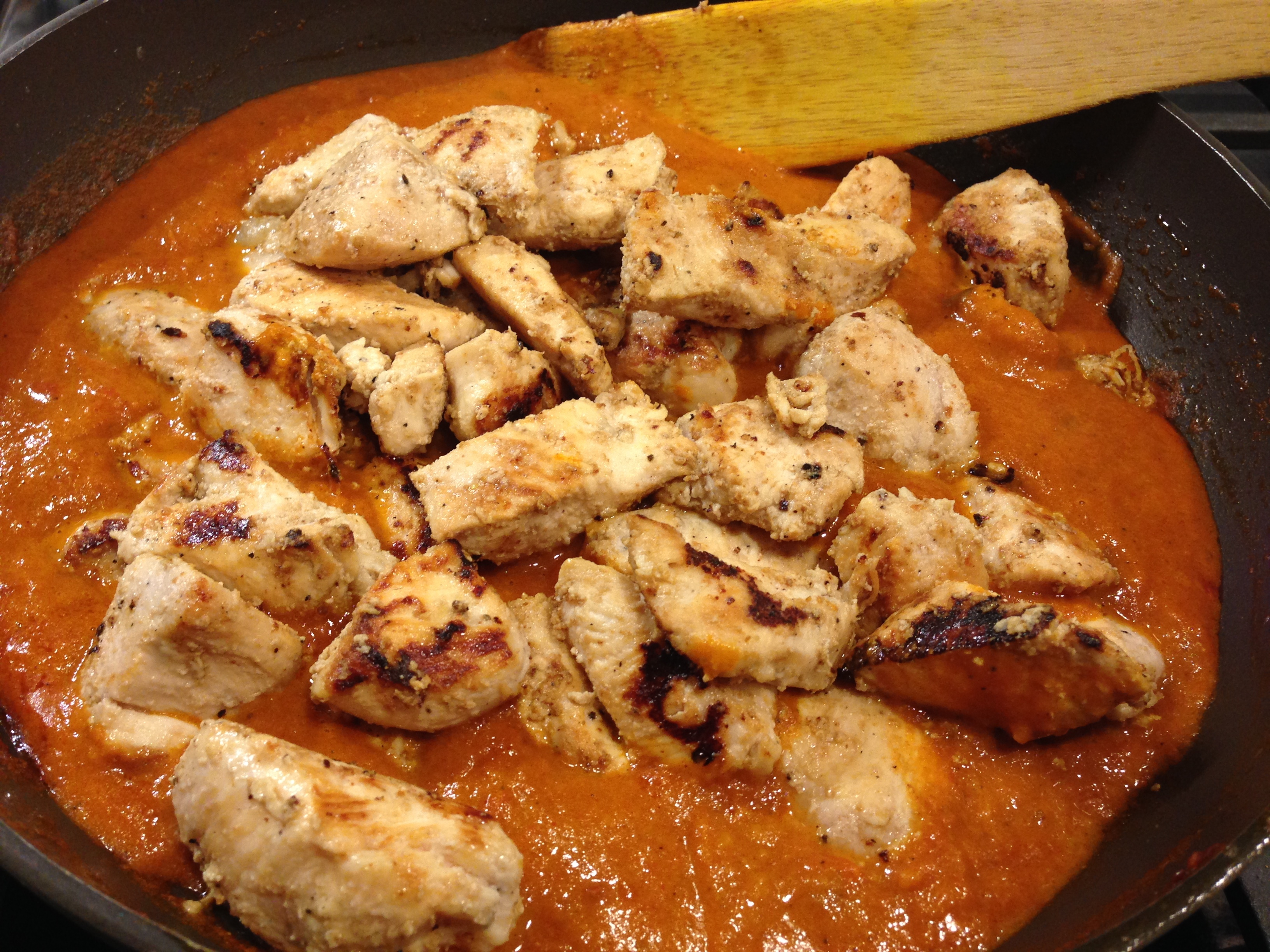
Pour back into the skillet and bring back up to a boil. Add the chicken and reduce the heat down to a simmer and cook for about 10 minutes.
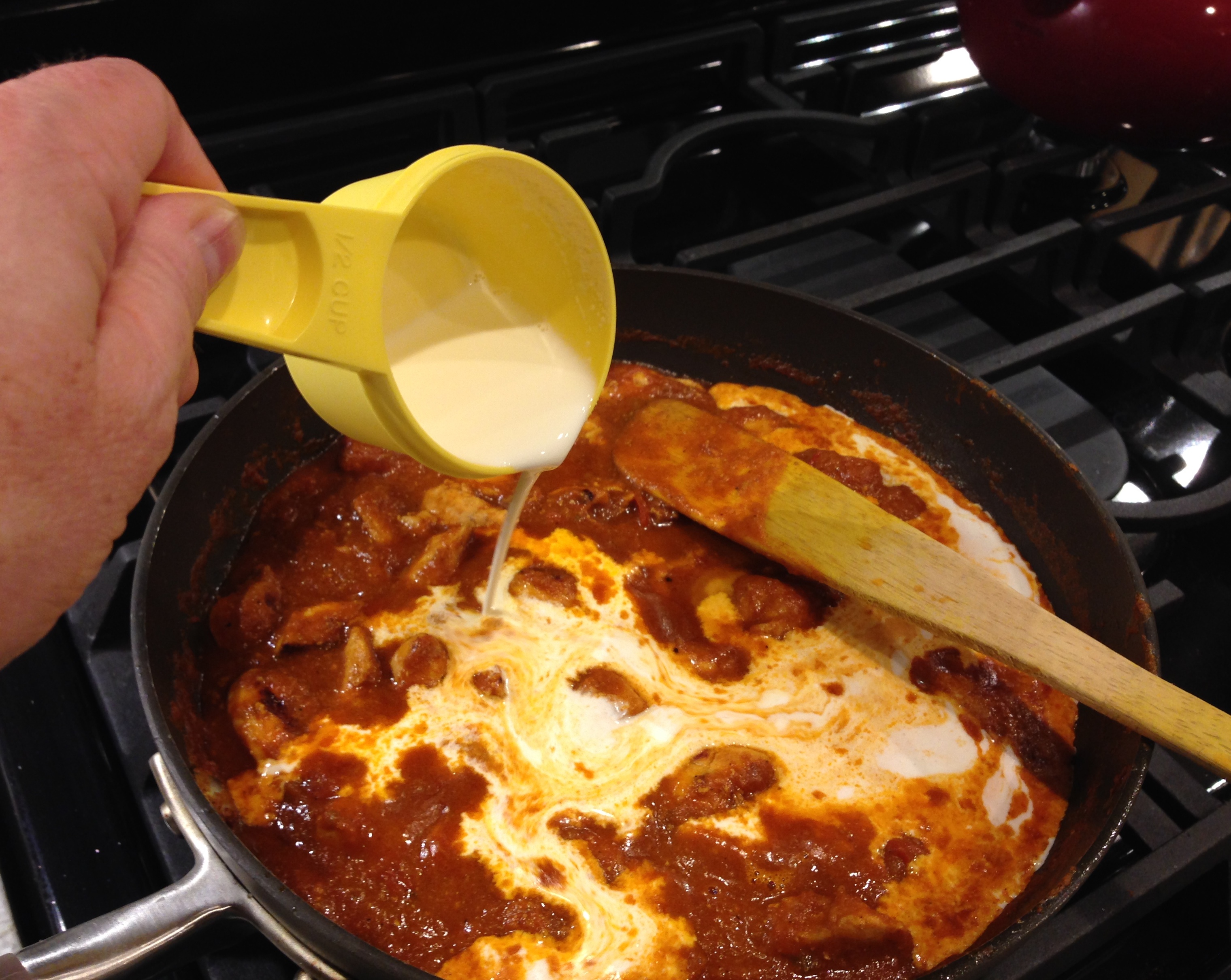
Add the cream and stir through. The cream will soften the acid from the tomatoes and create a perfect balance with the spices. This sauce is so good I just had to dip the tandoori bread in it while I was finishing up. Quality control is important too!
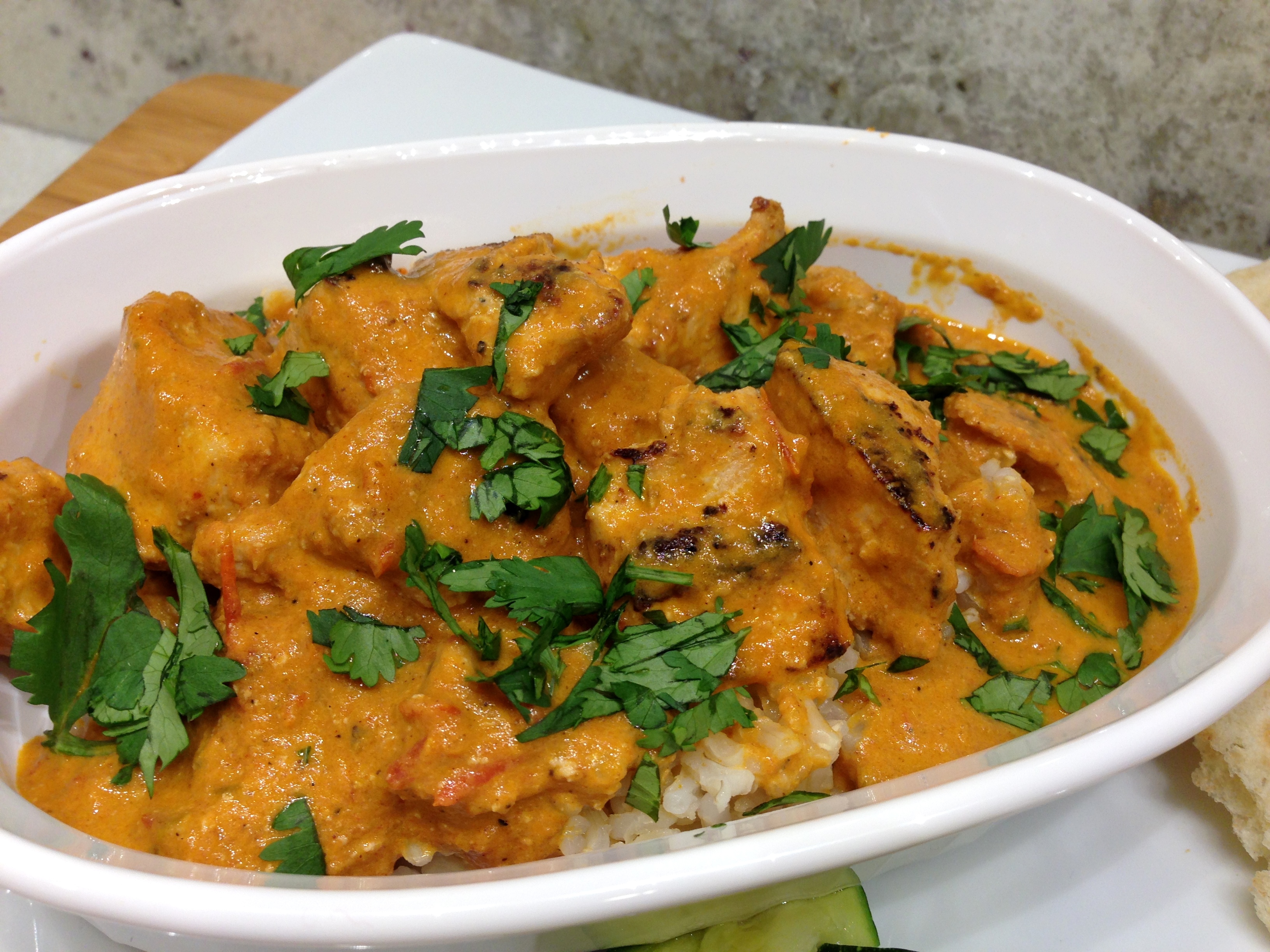
Garnish with chopped fresh cilantro and serve over rice, with naan, tandoori bread or a piece of crusty bread to sop up all of the yummy sauce!
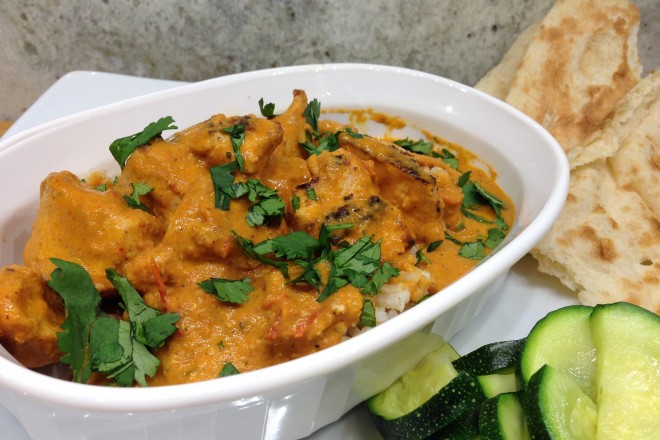

- 3/4 cup plain yogurt, whisked until smooth
- 1 tablespoon fresh ginger, grated
- 2 cloves garlic, grated
- 1 teaspoon kosher salt
- 1/2 teaspoon freshly ground black pepper
- 1 teaspoon lemon juice
- 2 large boneless, skinless chicken breasts, cut into 1-inch bite-sized chunks
- 2 teaspoons olive oil
- 3 tablespoons butter
- 4 cloves garlic, grated
- 2-inch thumb ginger, grated
- 1 Serrano pepper, minced (remove seeds and veins if you don't want it very spicy)
- 2 tablespoons tomato paste
- 1 teaspoon garam masala
- 2 teaspoons paprika
- 5 Roma tomatoes, seeded and diced
- 1 1/2 teaspoons kosher salt
- 1 cup water
- 1/2 cup heavy cream
- Fresh cilantro, chopped for garnish
- Serve over cooked rice with tandoori bread or naan, or a piece of crusty bread, for all the yummy sauce
- For the marinade: In a large bowl, mix together the marinade ingredients. Add the chicken and toss to coat. Marinate at least 30 minutes, or in the refrigerator up to overnight. If you marinate overnight, don’t add the lemon and salt until right before cooking or it will make the chicken dry when you cook it.
- For the sauce: When you're ready to make the curry, place a large skillet over medium heat and add the olive oil and butter. When the butter has melted, add the ginger, garlic and serrano peppers. Saute until lightly browned around the edges. Add the tomato paste and cook until the tomato has darkened in color, about 3 minutes. Add the garam masala and the paprika and saute for about 1 minute to bring out their flavors.
- Add the tomatoes, salt, and 1 cup water. Bring to a boil, turn down to a simmer, and cook until thickened, about 20 minutes. You may need more water depending on how juicy the tomatoes are.
- Fire up your grill. When it is really hot, lightly brush the grill pan with oil. Place the chicken in the grill pan, shaking off some of the excess marinade. Cook until meat is very browned, about 2 minutes on each side. (Don't worry that the chicken will still be a little uncooked, it finishes cooking in the sauce).
- Pour the sauce into a blender or food processor, or bowl and use an immersion blender; and process until smooth. Pour back into the skillet and bring back up to a boil. Add the chicken and reduce the heat down to a simmer and cook for about 10 minutes. Add the cream and stir through. Garnish with chopped fresh cilantro and serve over rice, with tandoori bread or naan, or a piece of crusty bread!

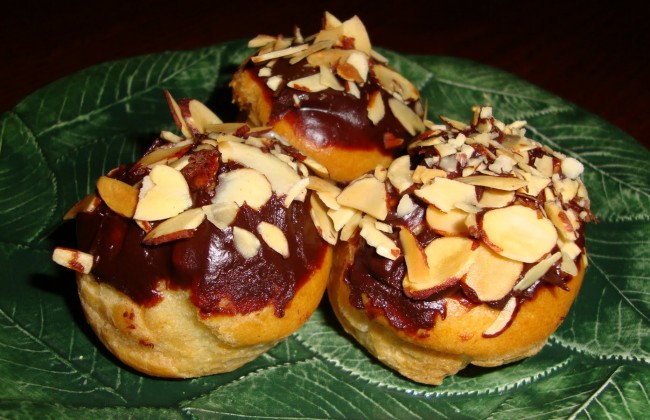

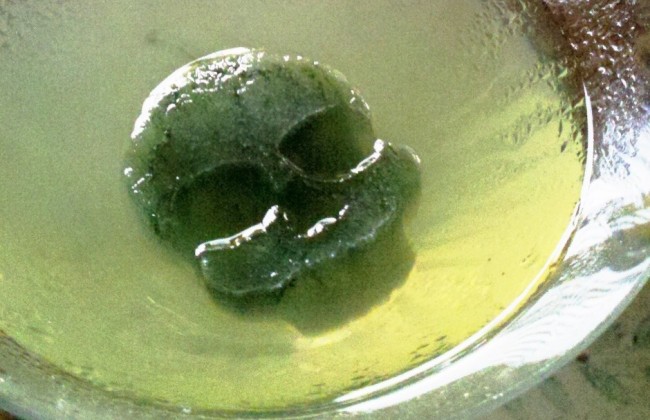
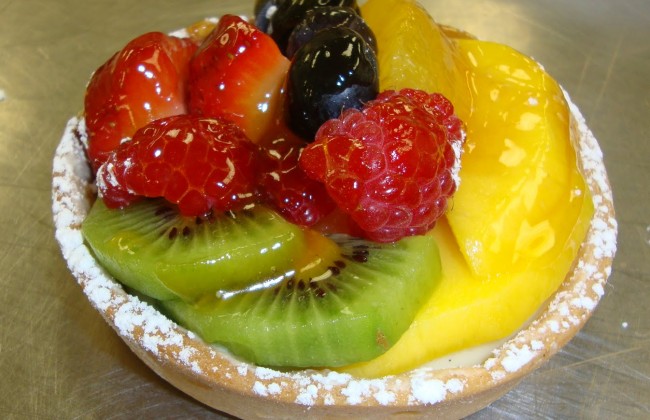
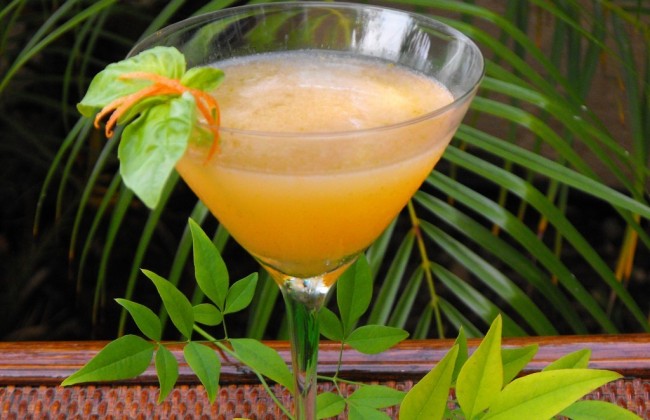
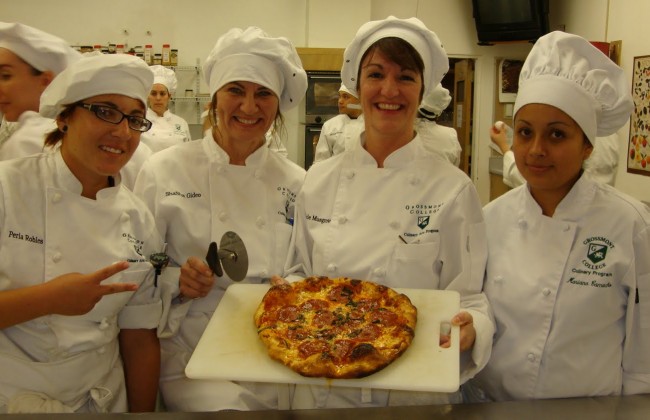
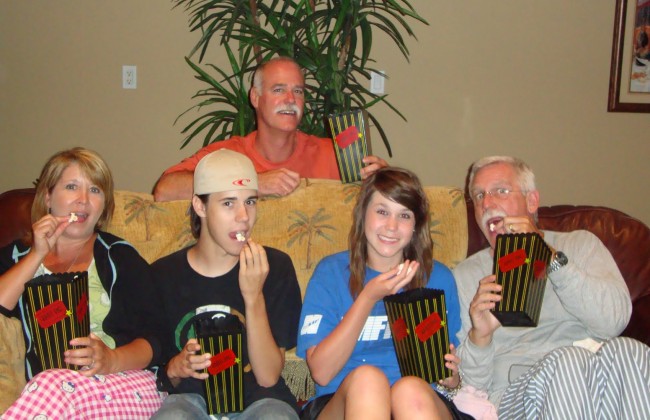
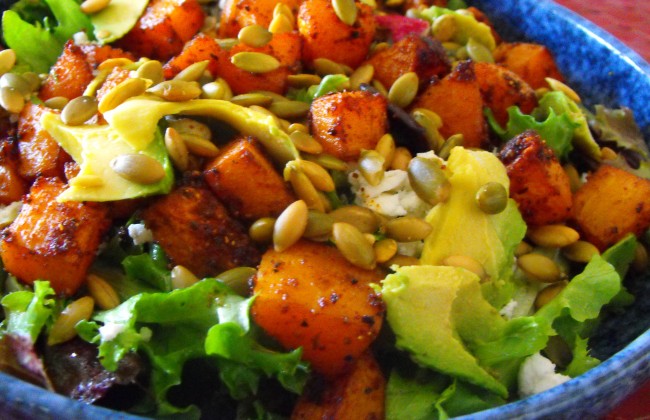

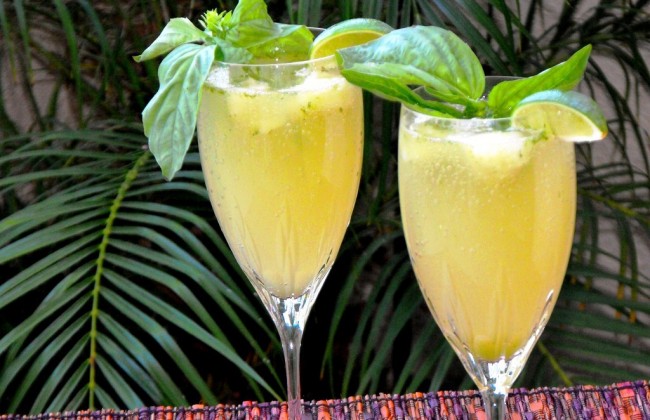
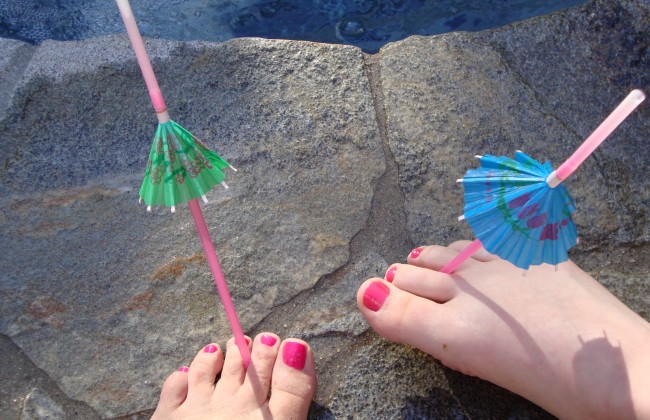
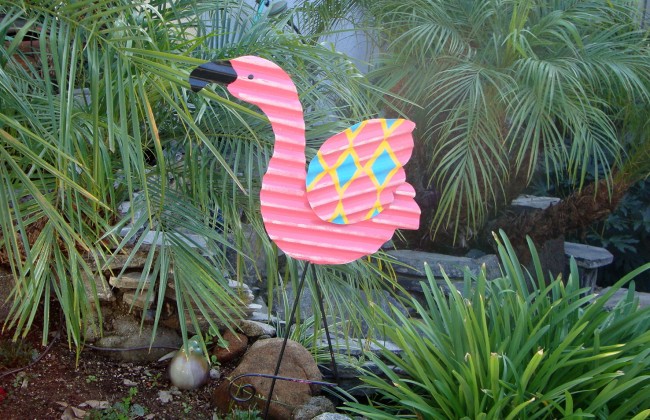
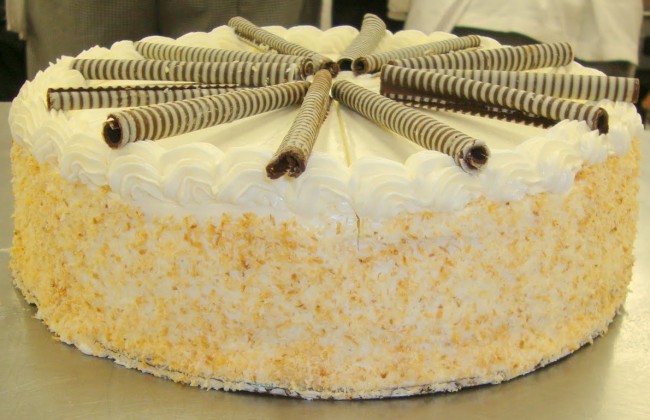

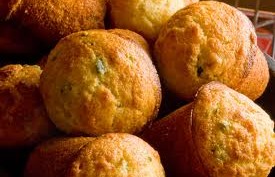
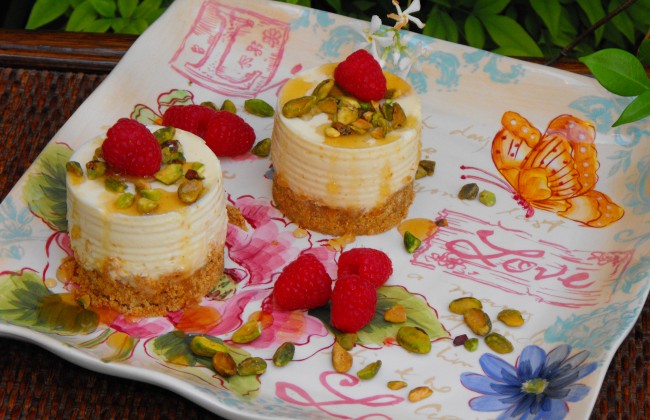
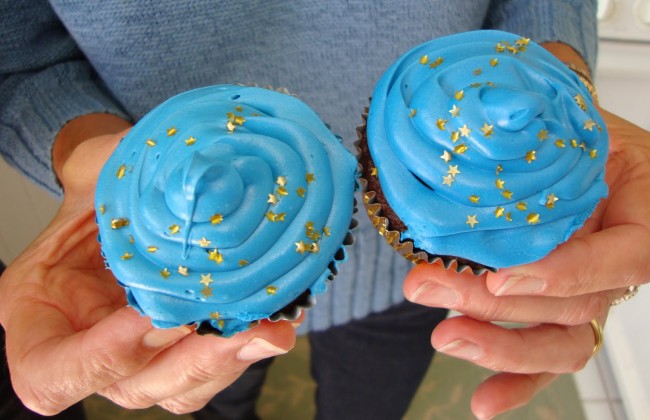
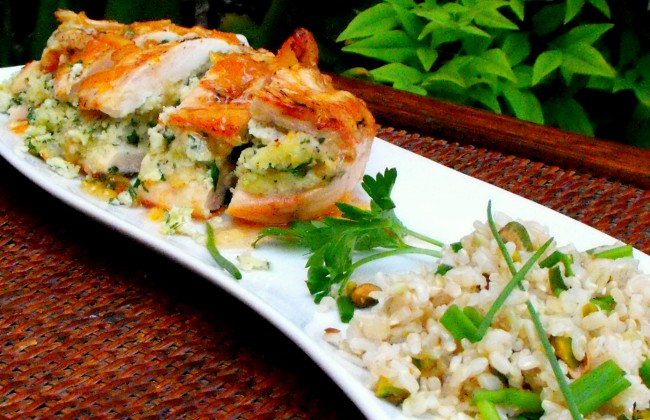
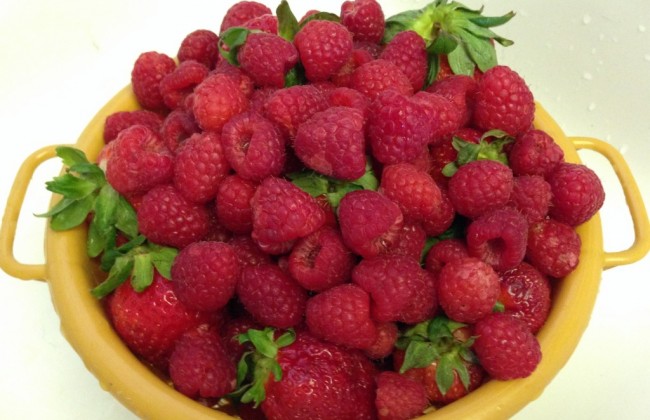
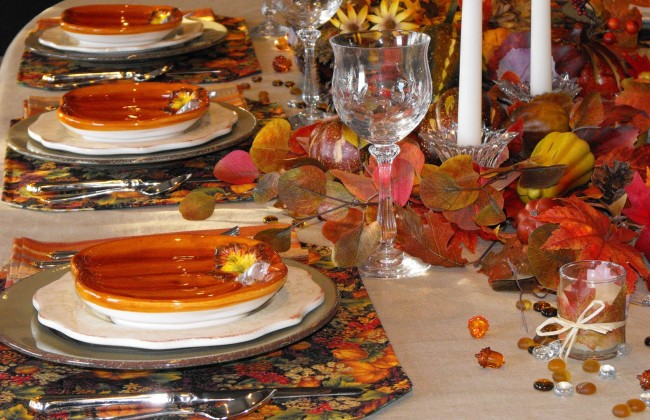
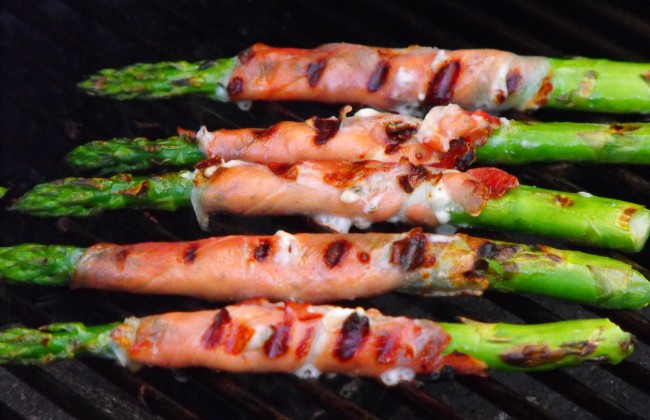

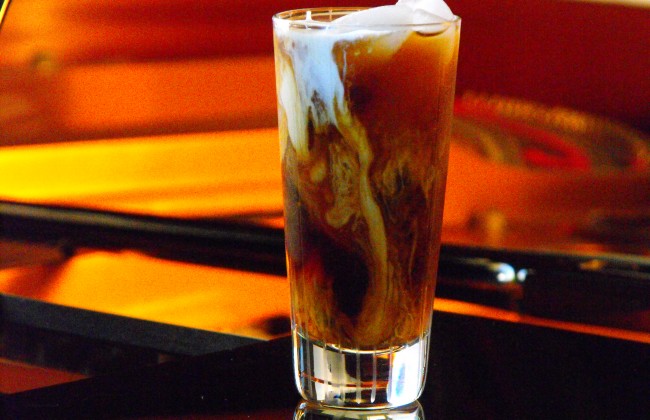
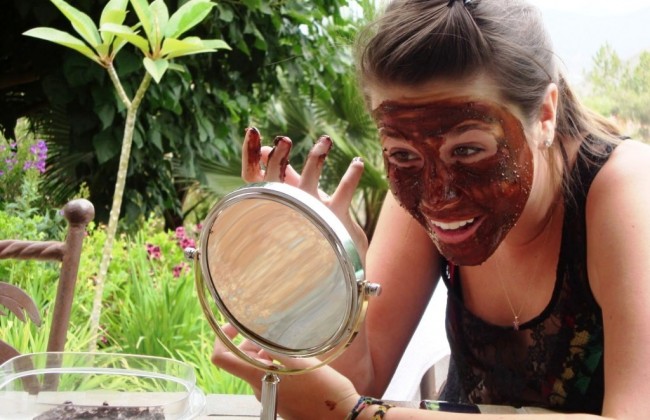
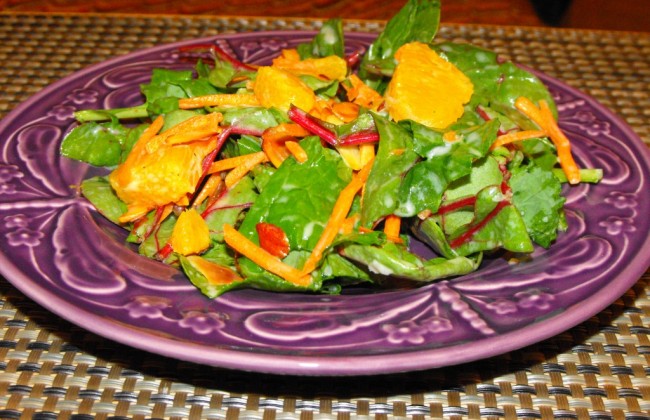
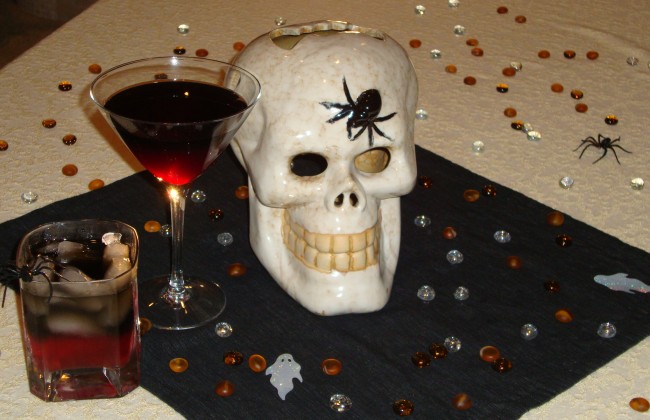
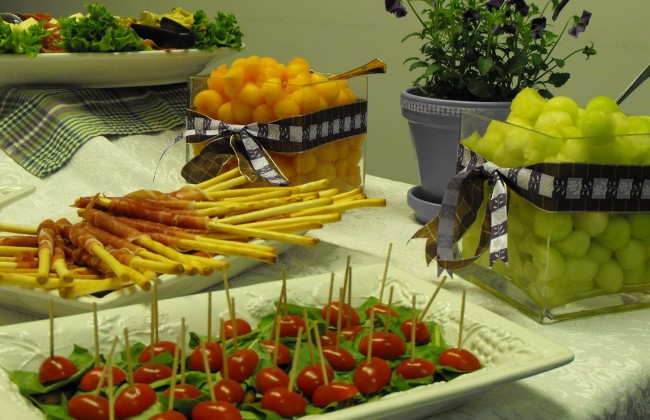



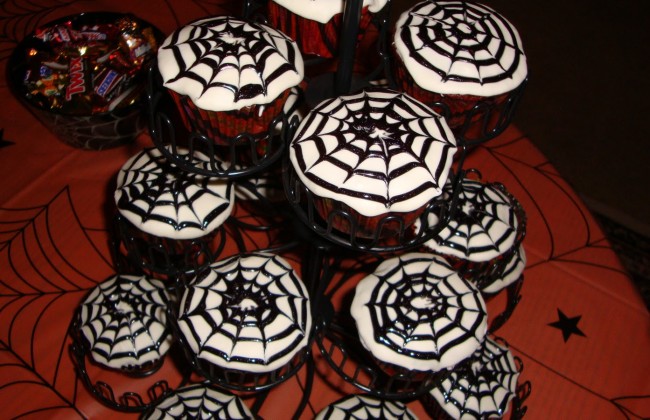


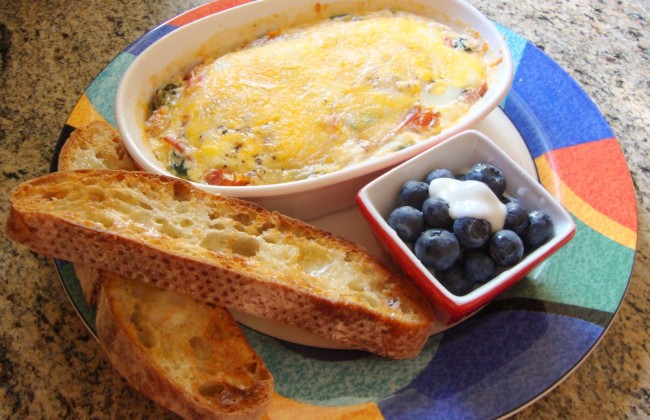
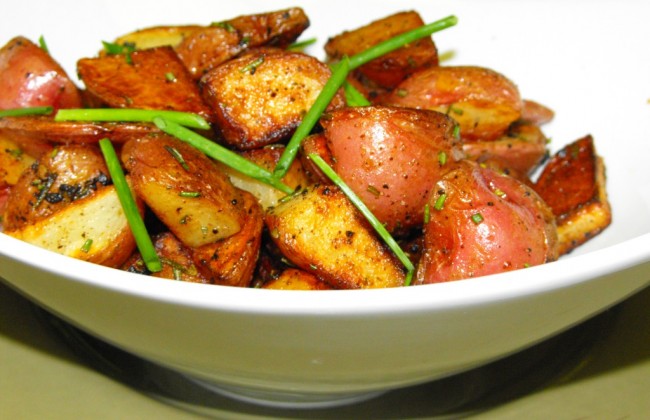



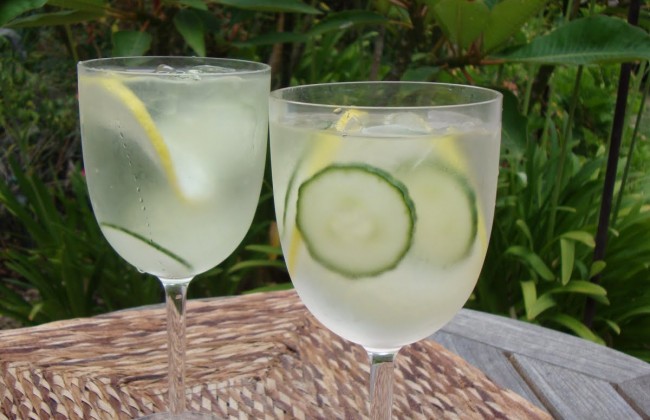
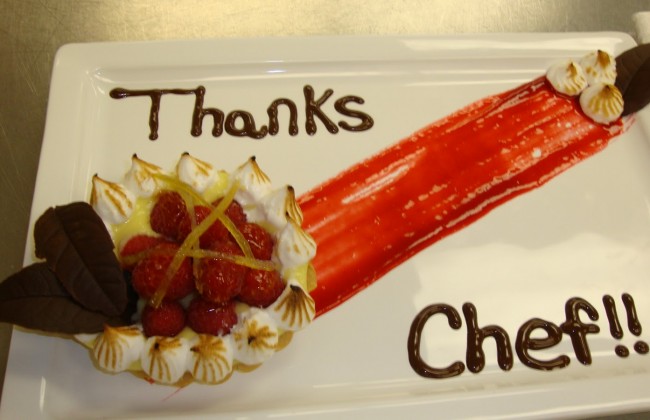



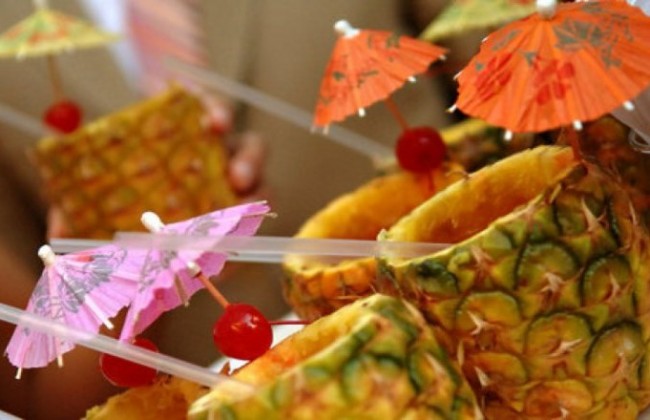
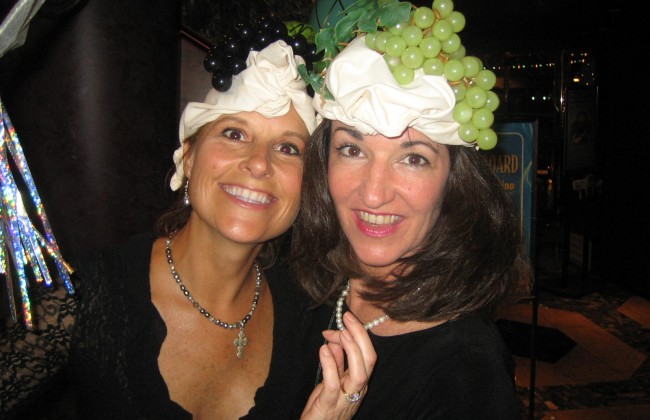



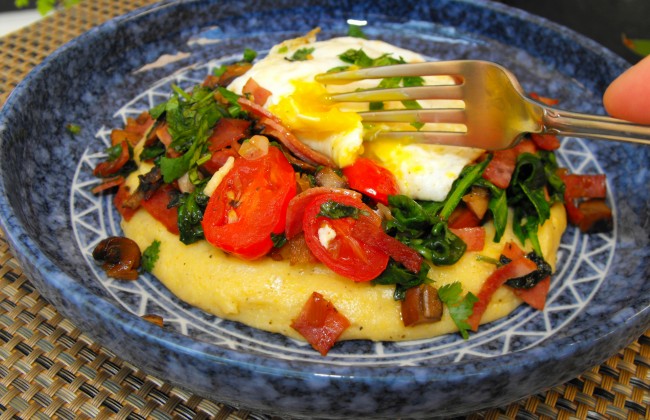



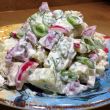
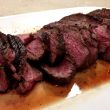

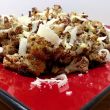
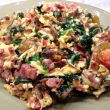
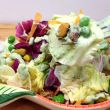

Thank you for the recipe! I can’t wait to make it. Do I follow the same marinade if I use shrimp instead chicken? Thanks.
Vivian ~ I would skip the marinade part if you are using shrimp. The marinade is great for chicken and will break down the fiber of the meat and make t tender and juicy. Shrimp doesn’t need or benefit from this. Make the sauce and when it starts to bubble slightly, add the shrimp and cook, stirring, until the shrimp turns opaque. Let me know how this turns out and I’ll try shrimp next time 🙂
Pingback: Delicious Indian Dinners ready to Eat ! Bolly Monday 10-27 - Durham Cool